| Blumwe family | |
|---|---|
| Entrepreneurs | |
.JPG.webp) View of Wilhelm Blumwe Villa in Gdańska Street | |
| Country | Kingdom of Prussia, German Empire |
| Current region | Bydgoszcz, Poland |
| Place of origin | Chojnice |
| Founded | 1850 |
| Founder | Carl Blumwe |
| Dissolution | 1903 |
Carl and Wilhelm Blumwe were successful German entrepreneurs, industrialists and businessmen in today's Bydgoszcz from the second half of the 19th century. Their buildings and realizations are still standing today in the city.
Blumwe family
Carl Blumwe
Source:[1]
Carl was born on October 20, 1827, in Chojnice. In his youth, he moved to Erfurt, where he learned the blacksmith business. He arrived in Bydgoszcz as a foreman in the Prussian Eastern Railway, around 1850, and lived at Dworcowa Street 42.
In 1865, he opened his own construction and repair workshop for agricultural machinery under his name "Carl Blumwe",[2] which moved in 1869 to a plot at Jagiellońska street 94. It was a small foundry, specialized in the manufacture of patent axle wagon and woodworking machines. In 1878, he bought from Julius Schmidt a small iron foundry on Nakelerstraße, expanded it and installed steam engines.[2] In 1878, the firm took the name of C. Blumwe and Son, since his son Wilhelm took over the management in the early 1880s. In 1884, the name changed to C. Blumwe and Son - Iron Foundry Specialized in patent axle wagon and woodworking machines: it is the ground base of today's Machine Tools Factory for Wood.
Soon, the facility was focused only to the production of saws, woodworking machines and steam engine. Thanks to its expertise and its excellent quality the company gained considerable notoriety: in 1886, it employed more than 100 workers.
Carl Blumwe died on March 11, 1887, in Bydgoszcz. The urn with his ashes was placed on top of his son's villa in downtown.[2] Carl Blumwe was married to Louise Heinrich, and had several children.

Wilhelm Blumwe
Franz Julius Wilhelm Blumwe[1] was born on August 11, 1853, in Erfurt. In Bydgoszcz, he attended in the mid-1850s his gymnasium and graduated in 1871. He then studied mechanical engineering, initially in Germany, then in England, Sweden and Denmark.[3] He returned to Bydgoszcz in 1878, to take over the management of his father's factory.
After his father's death in 1887, Wilhelm expanded workshops factory, installing lighting and electrical transmission equipment. In 1896, he built a then state-of-the-art iron foundry iron. In 1897, the firm was changed to a Joint Stock Company, with Wilhelm as main shareholders and director. At the end of the 19th century, the C. Blumwe and Son firm had branches in Berlin, Magdeburg and Cologne. Production was shipped throughout Europe, and even to China, United States and Africa. In 1899, the factory employed 22 managers and 250 workers. At its climax, the firm also owned additional plots on the northern side of Nakielska street, in front of the factory, used as storing area.[4]
In addition to his business, Wilhelm was deeply involved in social and charity movement. In 1889, workers with more than 10 years of employment at the factory received a savings account with 50 DM. He also created a health insurance system and a funeral cash system for his workers. In 1900, he established a home care for employees' children in a nearby villa (today at Nakielska street 47).
He was a member of the National Liberal Party, but did not take an active part in political activities. For many years, he acted in the local Chamber of Commerce and became a Member of the Board in 1897. He also participated in the works of the Historical Society of the Netze District and Bromberg's German Society of Arts and Sciences. In both societies, he served as a board member.
In the years 1896-1897 he built his house at Gdańska Street 50, where he lived with his wife and mother. He married in 1880 Marie Christiane Clara Strelow, daughter of Julius Strelow, owner of a local brewery. They did not have children. Wilhelm died on September 26, 1903, in Bydgoszcz. His company survived him until today.
Villa Wilhelm Blumwe
Registered on the Kuyavian-Pomeranian heritage list, Nr.601306-Reg.A/1129, July 8, 1992, and September 29, 1998[5] 1900–1904, by Hildebrandt.
The building was erected between 1900 and 1904[6] by architect Hildebrandt from Berlin. The investor was Wilhelm Blumwe, son of Carl Blumwe.
The building has the classical shape of a palace, with a style referring to Palladian architecture,[7] popular in Europe in the late 19th century.
 Villa Wilhelm Blumwe 1907 (right side)
Villa Wilhelm Blumwe 1907 (right side).JPG.webp) View from Gdańska street
View from Gdańska street
Villa Carl Blumwe
1850s–1890s, reconstruction by Carl Stampehl
The Villa Carla Blumwe is a former industrial building that belonged to factory managers Carl and Wilhelm Blumwe. The building is located at Nakielska street 53 in Bydgoszcz. Its architectural features can be connected with identical industry-related edifices from the second half of the 19th century in Łódź and Warsaw.
The construction of the Villa happened in several stages, led by the successful development of the neighbouring "Factory of Machine Tools for wood", on which plot it has been built. The oldest part of the premises, made of wattle and daub, was built in the 1850s, while its north façade, erected only in 1879, is made of bricks as a single-storey building with a separate entrance.
On December 12, 1892, Wilhelm Blumwe applied for the reconstruction and expansion of his a dwelling house. He asked designer Carl Stampehl, a master mason and carpenter, to realize this project. At this time, Carl Stampehl was already known for designing tenements in Gdańska Street (No. 16 and Nr.22). For the villa, Carl Stampehl carried out in 1893:
- the reconstruction of the old house's interior;
- the addition of an attic;
- the building of a columned column porch.
A tower was also added on the western part, along with a new wing devoted to business offices. All architectural details on the facade were revamped, giving a uniformity to the structure. Another building addition was performed in 1900. After World War II, an intensive refurbishing outside and inside has obliterated a major part of architectural details. Throughout its existence, the villa was part of "Factory of Machine Tools for wood".[8]
The building design refers to rich neo-Baroque villas. The oldest eastern part has an asymmetrical facade, with a wooden cornice supported by corbels and a wattle and daub wall, filled with ceramic bricks. The brick office building reminds strongly of the industrialists' realisations from the end of the 19th century. The southern main entrance is preceded by a porch, only survival a two-column shaped portico. Above the door is placed a cornice, with a cartouche supported by two putti. The facade of the tower has bossage stones topped with friezes, with symbolic crossed hammers below each windows.[9] Above is set is Mansard roof capped by a bulging, wrought-iron spire.
The villa represents an eclectic style of architecture, with much brick and a clear predominance of neo-Baroque elements. The style and richly adorned façade onto the street identified the social position of the family industrialists who owned the villa.[8]
 View from Nakielska street
View from Nakielska street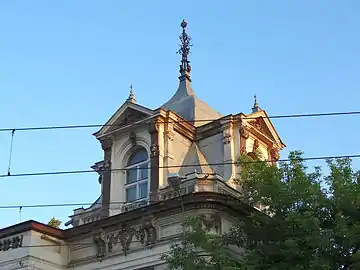 Tower and its finial
Tower and its finial Detail of the Mansard roof
Detail of the Mansard roof Detail of a pediment
Detail of a pediment Detail of the finial
Detail of the finial
Factory of Machine Tools for wood
1865
Nakielska street 55/57 and 129/131
History
Fabryka Obrabiarek do Drewna (FOD) is one of the oldest (1865) active companies in Bydgoszcz, producing machines and equipment for wood processing, and now also complete technological lines for the wood industry.[10] It is the oldest in Poland company in its sector.[10] The plot was initially occupied by a paper mill as early as 1802, then welcomed in 1839 the first machine production plant in Bydgoszcz, "Plagemann's agricultural equipment factory".[11]
Looking for a better location for its plant, Carl Blumwe bought in 1878 a piece of land with buildings from the widow of an iron foundry owner, Julius Schmidt,[9] in Wilczak district (now Nakielska St. 53). The same year, the company turned to his son Wihelm who changed its business name to "Carl Blumwe and Son" (German: C. Blumwe & Sohn Eisengießerei in. Special - Fabrik für Patentwagenachsen und Holzbearbeitungsmaschinen). In 1886, the plant employed more than 100 workers, and expanded its production to steam engines.[12]
The Bydgoszcz wood harbour, established in 1879 and expanded in 1905–1917, contributed significantly to the rapid development of the local timber industry after 1890.[13] The entire local timber industry has developed using the waterway transit to Germany, employing 6,200 people at its peak, and enabled the development of enterprises producing machines and equipment for woodworking.[13] Wilhelm Blumwe modernized its plant with technical improvements and transformed it into a joint stock company in 1897. The company had seats in Berlin, Magdeburg, Cologne, and goods exported, among others, to China, United States and Africa. Wilhelm Blumwe died in 1903.[12]
During the interwar period, FOD corporation was incorporated as a subsidiary to the company's "Pomeranian Grudziądz Machine Factory SA". On July 1, 1928, Bydgoszcz branch -formerly C. Blumwe and Son- became independent under the name "Factory Thracians and Machines for Metal Woods".[12] After the Great Depression, in 1931, the factory employment had fallen to 100 people, to 50 people in 1930.[14] The re-development of the factory started up in 1935–1939.[12]
After the outbreak of World War II and Nazi occupation of Bydgoszcz, the company was confiscated by the German Central Office Trust - East. They put back the original German company name, i.e. "Fabrik für Holzverarbeitungsmaschinen Blumwe und Co. AG".[15] The factory was militarized, but continued its production of machinery and equipment for the wood industry.
In 1945, in the first days after the liberation Bydgoszcz, the plant resumed its operations. Initially the factory started to produce for the military, but quickly returned to its original production profile, satisfying the needs of the timber industry.[16] In the years 1950–1955, the plant was expanded according to the Six-Year Plan, which granted priority to the expansion of heavy industry.[17] In 1970 decision was made to specialize the plant in the production lines for the sawmill industry.[12]
In November 2011, Minister of Finance has announced a public offer for the sale of 85% of the share capital of the company. This offer comprised the sale of the plot at Nakielska street 129/131. Since 2012–2013, buildings at Nr.131 have been cleaned out to allow the construction of a residence complex. The brick edifice at Nr.129 still remains.
The ensemble at 55/57, sold out in May 2020, will be partially torn down to give way to a large real estate project.[18]
Architecture
The factory complex has been built in the second half of the 19th century, to the like of well-known industrial similar buildings in Łódź or Warsaw. Owner's villa has been erected within the plant area. The factory building is connected to the prestigious residential and office, emphasizing the social status of the manufacturer, while at the same time contrasting with the austere, brick-architecture of the factory halls.[12]
From the historical ensemble, buildings still preserved to this day are:[12]
- "Carl Blumwe" Villa, in a Neo-Baroque style, used as an office building (1850–1900);
- The assembly hall (1896–1897), with a Neo-gothic facade;
- The lathe ward, now the gatekeeper lodge (1895–1900).
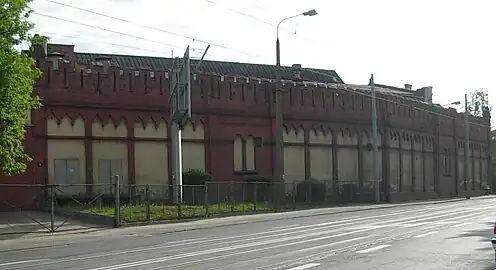 View on the assembly hall from Nakielska street
View on the assembly hall from Nakielska street View from Nakielska street
View from Nakielska street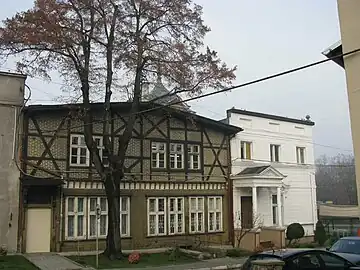 View on the main gate, the lathe ward and part of "Carl Blumwe" Villa
View on the main gate, the lathe ward and part of "Carl Blumwe" Villa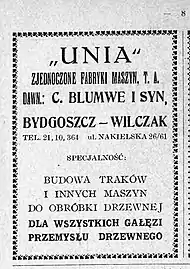 Advertising for Blumwe Company in 1925
Advertising for Blumwe Company in 1925
Blumwe's kinderheim
1898, by Fritz Weidner
German Historicism
The villa has been erected at the end of the 19th century by eminent Bydgoszcz architect Fritz Weidner. Fritz Weidner, at the time, had already realized many edifices downtown: in Gdańska Street (28,79, 91, 119), August Cieszkowski Street (22), Dworcowa Street (71).
Initial address was Nakelerstraße 21.[19] In 1900, Wilhelm Blumwe established in this house a home care for his employees' children (German: kinderheime): there had been residing an average of 120 children daily, under the tutelage of two deaconess sisters. In 1902, the villa housed in addition a center for deaconesses as nurses's training center. In the 1920s, after the re-establishment of the Polish state, the edifice was donated as a house for Deaconesses (Polish: Dom Diakonisek).
Today, the villa is a property of the Polish Health Care System and welcomes a local dispensary.
 The Villa in 1911
The Villa in 1911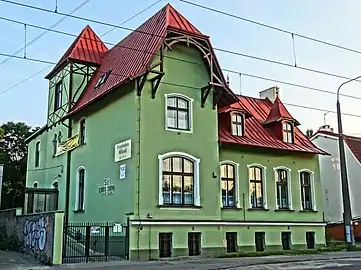 View from Nakielska Street
View from Nakielska Street
References
- 1 2 Błażejewski Stanisław, Kutta Janusz Romaniuk Marek (1996). Bydgoski Słownik Biograficzny. Tom III. Bydgoszcz: Kujawsko-Pomorskie Tow. Kulturalne. p. 41. ISBN 83-85327-32-0.
- 1 2 3 Czajkowski, Edmund (1987). Na ntarginesie pewllej inforntacji. Kalendarz Bydgoski. Bydgoszcz: Towarzystwo Miłośników Miasta Bydgoszczy. pp. 39–41.
- ↑ "Fabryka Obrabiarek do Drewna". ludzieitechnika.pl. Szlak Wody Przemysłu i Rzemiosła. Retrieved 8 January 2016.
- ↑ "Straßen". Adressbuch nebst allgemeinem Geschäfts-Anzeiger von Bromberg mit Vorvorten für 1900: auf Grund amtlicher und privater Unterlagen. Bromberg: Dittmann. 1900. p. 81.
- ↑ zabytek-kujawsko-pomorskie-28.02.2014
- ↑ "Najpierw willa potem radio". bydgoszcz.gazeta.pl. bydgoszcz.gazeta. 2016. Retrieved 13 November 2016.
- ↑ Parucka, Krystyna (2008). Zabytki Bydgoszczy. Bydgoszcz: minikatalog. "Tifen" Krystyna Parucka. ISBN 978-83-927191-0-6.
- 1 2 Brzozowska Iwona, Derkowska-Kostkowska Bogna (1997). Fabryka Carla i Wilhelma Blumwe na bydgoskim Wilczaku. Bydgoszcz: Materiały do dziejów kultury i sztuki Bydgoszczy i regionu. Zeszyt 2.
- 1 2 Koronowskie Stowarzyszenie Rozwoju Turystyki „Szczesliwa Dolina” (30 September 2013). Raport z inwentaryzacji i waloryzacji dziedzictwa przemyslowego Bydgoszczy na cele szlaku kulturowego. Bydgoszcz: SHIFT-X project. p. 43.
- 1 2 "Fabryka Obrabiarek do Drewna". fod.com.pl. DyalCom. 2013. Retrieved 6 June 2016.
- ↑ Bydgoszcz Guide. Bydgoszcz: City of Bydgoszcz. July 2014. p. 22. ISBN 83-917786-7-3.
- 1 2 3 4 5 6 7 Brzozowska Iwona, Derkowska-Kostkowska Bogna (1997). Fabryka Carla i Wilhelma Blumwe na bydgoskim Wilczaku - Materiały do dziejów kultury i sztuki Bydgoszczy i regionu. Zeszyt 2. Bydgoszcz: Pracownia Dokumentacji i Popularyzacji Zabytków Wojewódzkiego Ośrodka Kultury w Bydgoszczy.
- 1 2 Sławińska, Krystyna (1969). Przemysł drzewny w Bydgoszczy i w okolicy w latach 1871-1914: Prace Komisji Historii t. VI. Bydgoszcz: Bydgoskie Towarzystwo Naukowe. Prace Wydziału Nauk Humanistycznych. Seria C.
- ↑ Biskup, Marian (1999). Historia Bydgoszczy. Tom II cz. 1 1920-1939. Bydgoszcz: Bydgoskie Towarzystwo Naukowe. p. 123. ISBN 83-901329-0-7.
- ↑ Biskup, Marian (2004). Historia Bydgoszczy. Tom II cz. 2 1939-1945. Bydgoszcz: Bydgoskie Towarzystwo Naukowe. p. 245. ISBN 83-921454-0-2.
- ↑ Michalski, Stanisław (1988). Bydgoszcz wczoraj i dziś 1945-1980. Bydgoskie Towarzystwo Naukowe, Państwowe Wydawnictwo Naukowe Warszawa-Poznań. p. 64.
- ↑ Michalski, Stanisław (1988). Bydgoszcz wczoraj i dziś 1945-1980. Bydgoskie Towarzystwo Naukowe, Państwowe Wydawnictwo Naukowe Warszawa-Poznań. p. 75.
- ↑ Glugla, Jacek (22 January 2021). "Nowe osiedle przy Nakielskiej z zabytkami i ciekawym placem. Hala była zagrożona". bydgoszcz.wyborcza.pl. GAzeta Wyborxza. Retrieved 1 February 2021.
- ↑ "Straßen". Adressbuch nebst allgemeinem Geschäfts-Anzeiger von Bromberg mit Vorvorten für 1900: auf Grund amtlicher und privater Unterlagenlocation=Bromberg. Dittmann. 1900. p. 21.
Bibliography
- Brzozowska Iwona, Derkowska-Kostkowska Bogna (1997). Fabryka Carla i Wilhelma Blumwe na bydgoskim Wilczaku. Materiały do dziejów kultury i sztuki Bydgoszczy i regionu. Zeszyt 2 (in Polish). Bydgoszcz: Pracownia dokumentacji i popularyzacji zabytków wojewódzkiego ośrodka kultury w Bydgoszczy. pp. 71–82.
- Wysocka, Agnieszka (1997). Willa Blumwego. Materiały do dziejów kultury i sztuki Bydgoszczy i regionu. Zeszyt 2 (in Polish). Bydgoszcz: Pracownia dokumentacji i popularyzacji zabytków wojewódzkiego ośrodka kultury w Bydgoszczy. pp. 67–70.
- Błażejewski Stanisław, Kutta Janusz, Romaniuk Marek (1996). Bydgoski Słownik Biograficzny. Tom III (in Polish). Bydgoszcz: Kujawsko-Pomorskie Towarzystwo Kulturalne Wojewódzki Ośrodek Kultury. ISBN 8385327320.
